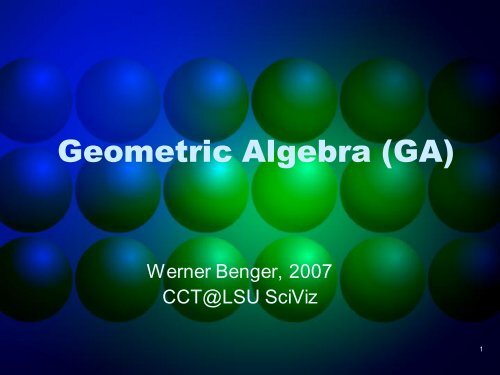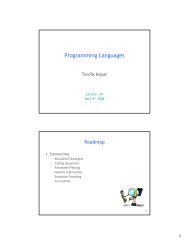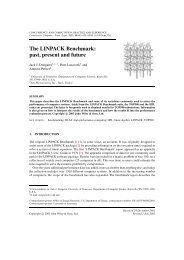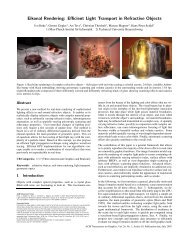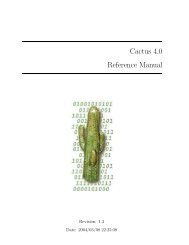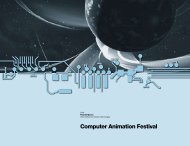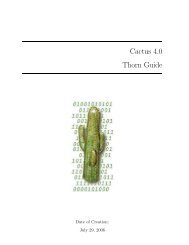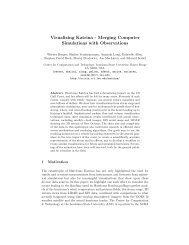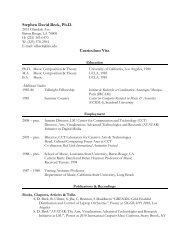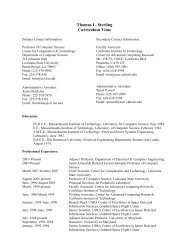You also want an ePaper? Increase the reach of your titles
YUMPU automatically turns print PDFs into web optimized ePapers that Google loves.
Geometric Algebra (<strong>GA</strong>)<br />
Werner B<strong>en</strong>ger, 2007<br />
CCT@LSU SciViz<br />
1
Abstract<br />
• Geometric Algebra (<strong>GA</strong>) d<strong>en</strong>otes the re-discovery and geometrical interpretation of<br />
the Clifford algebra applied to real fields. Hereby the so-called „geometrical product“<br />
allows to expand linear algebra (as used in vector calculus in 3D) by an invertible<br />
operation to multiply and divide vectors. In two dim<strong>en</strong>ions, the geometric algebra can<br />
be interpreted as the algebra of complex numbers. In ext<strong>en</strong>ds in a natural way into<br />
three dim<strong>en</strong>sions and corresponds to the well-known quaternions there, which are<br />
widely used to describe rotations in 3D as an alternative superior to matrix calculus.<br />
However, in contrast to quaternions, <strong>GA</strong> comes with a direct geometrical<br />
interpretation of the respective operations and allows a much finer differ<strong>en</strong>tation<br />
among the involved objects than is achieveable via quaternions. Moreover, the<br />
formalism of <strong>GA</strong> is indep<strong>en</strong>d<strong>en</strong>t from the dim<strong>en</strong>sion of space. For instance, rotations<br />
and reflections of objects of arbitrary dim<strong>en</strong>sions can be easily described intuitively<br />
and g<strong>en</strong>eric in spaces of arbitrary higher dim<strong>en</strong>sions.<br />
• Due to the elegance of the <strong>GA</strong> and its wide applicabililty it is sometimes d<strong>en</strong>oted as a<br />
new „fundam<strong>en</strong>tal language of mathematics“. Its unified formalism covers domains<br />
such as differ<strong>en</strong>tial geometry (relativity theory), quantum mechanics, robotics and last<br />
but not least computer graphics in a natural way.<br />
• This talk will pres<strong>en</strong>t the basics of Geometric Algebra and specifically emphasizes on<br />
the visualization of its elem<strong>en</strong>tary operations. Furthermore, the pot<strong>en</strong>tial of <strong>GA</strong> will be<br />
demonstrated via usage in various application domains.<br />
2
Motivation of <strong>GA</strong><br />
• Unification of many domains: quantum<br />
mechanics, computer graphics, g<strong>en</strong>eral relativity,<br />
robotics…<br />
• Completing algebraic operations on vectors<br />
• Unified concept for geometry and algebra<br />
• Superior formalism for rotations in arbitrary<br />
dim<strong>en</strong>sions<br />
• Explicit geometrical interpretation of the<br />
involved objects and operations on them<br />
3
Definition: “Algebra”<br />
• Vector space V over field K with<br />
multiplication “ ”<br />
• Null-elem<strong>en</strong>t, One-elem<strong>en</strong>t, Inverse<br />
• Commutative? a b = b a<br />
• Associative? (a b) c = a (b c)<br />
• Division algebra?<br />
• a≠0 a -1 such that a a -1 = 1 = a -1 a<br />
• Alternatively: a b=0 � a=0 or b=0<br />
4
Historical Roots<br />
• Complex Plane (Gauss ~1800)<br />
• Real/Imaginary part: a+ib where i 2 = -1<br />
• Associative, commutative division-algebra<br />
• Polar repres<strong>en</strong>tation: r e i = r ( cos + i sin )<br />
• Multiplication corresponds to rotation in the plane<br />
i<br />
cos<br />
sin<br />
5
Historical Roots, II<br />
William Rowan Hamilton (1805-65)<br />
inv<strong>en</strong>ts Quaternions (1844):<br />
– G<strong>en</strong>eralization of complex numbers:<br />
• 4 compon<strong>en</strong>ts, non commutative: ab ba<br />
(in g<strong>en</strong>eral)<br />
• Basic idea: ii=jj=kk= ijk = -1<br />
• Alternative to younger vector- and matrix<br />
algebra (Josiah Willard Gibbs, 1839-1903)<br />
• p=(p,p), q=(q,q), p q=(pq - p q , pq + pq<br />
+ p q)<br />
• rotation in R 3 are around axis of the vector<br />
compon<strong>en</strong>t: v’ = q v q -1<br />
6
Historical Roots, III<br />
• Construction by Cayley-Dickson<br />
(a,b)(c,d) = (ac-d *b, *a d+cb)<br />
– hypercomplex numbers:<br />
• octaves/octonions (8 compon<strong>en</strong>ts)<br />
• sed<strong>en</strong>ions/hexadekanions (16 compon<strong>en</strong>ts)<br />
• …<br />
– increm<strong>en</strong>tal loss of<br />
• commutativity (quaternions,…)<br />
• associativity (octonions,…)<br />
• division algebra (sed<strong>en</strong>ions,…)<br />
7
R<strong>en</strong>aissance of the <strong>GA</strong><br />
1878: Clifford introduces “geometric algebra”, but dies at age 34<br />
� superseded by Gibb’s vector calculus<br />
1920er: R<strong>en</strong>aissance in quantum mechanics (Pauli, Dirac)<br />
algebra on complex fields<br />
no geometrical interpretation<br />
1966-2005 David Hest<strong>en</strong>es (Arizona State University) revives the<br />
geometrical interpretation<br />
1997: Gravitation theory using <strong>GA</strong> (Las<strong>en</strong>by, Doran, Gull; Cambridge)<br />
2001: Geometric Algebra at SIGGRAPH (L. Dorst, S. Mann)<br />
8
Geometry and Vectors<br />
• Geometric interpretation of a vector<br />
– Directed line segm<strong>en</strong>t or tang<strong>en</strong>t<br />
• Vector-algebra in Euclidean Geometry or T p(M)<br />
• Addition / subtraction of vectors a+b<br />
• Multiplication / division by scalars a<br />
• Multiplication / Division of vectors??<br />
Multiplication of vectors<br />
10
Complete Vector-algebra?<br />
• Invertible product of vectors?<br />
• What means vector-division “a/b” ?<br />
• ab=C � b=a -1 C<br />
• Note: C not necessarily a vector!<br />
• Inner product (not associative): a b � Skalar<br />
– Not invertible<br />
e.g. a b =0 with a≠0, b≠0 but orthogonal<br />
• Outer product (associative): a b � Bivektor<br />
– G<strong>en</strong>eralized cross-product from 3D: a b<br />
– Not invertible<br />
e.g. a b =0 with a≠0, b≠0 but parallel<br />
Multiplikation von Vector<strong>en</strong><br />
11
Bivector a b<br />
Describes the plane spun by a and b,<br />
sign is ori<strong>en</strong>tation<br />
a b<br />
b a = -a b<br />
Defined in arbitrary dim<strong>en</strong>sions, anti-symmetric (� not commutative),<br />
associative, distributive, spans a vector space, does not require additional<br />
structures<br />
Multiplikation von Vektor<strong>en</strong><br />
12
Constructing Bivectors<br />
No unique determination of the g<strong>en</strong>erating vectors possible<br />
a b = (a+λb) b<br />
b b =0<br />
Basis-elem<strong>en</strong>t<br />
|a| |b| sin<br />
=<br />
Multiplikation von Vektor<strong>en</strong><br />
=<br />
a+λb<br />
b<br />
13
Bivectors in R 3<br />
• 3 Basis-elem<strong>en</strong>ts<br />
e x e y, e y e z, e z e x<br />
• G<strong>en</strong>eralization: e x e y e z is a volume<br />
Multiplikation von Vektor<strong>en</strong><br />
14
Vectorspace of Bivectors<br />
Linear combinations possible<br />
e.g.: e x e y, e z e x<br />
Multiplikation von Vektor<strong>en</strong><br />
15
Coordinate repres<strong>en</strong>tation<br />
of “ ”-product in R 3<br />
• G<strong>en</strong>eric Bivector:<br />
A = A xy e x e y + A yz e y e z + A zx e z e x<br />
• (a xe x + a ye y + a ze z) (b xe x + b ye y + b ze z)=<br />
a xe x b xe x + a xe x b ye y + a xe x b ze z +<br />
a ye y b xe x + a ye y b ye y + a ye y b ze z +<br />
a ze z b xe x + a ze z b ye y + a ze z b ze z =<br />
(a xb y - a yb x)e xy+(a yb z-a zb y)e yz+(a xb za<br />
zb x)e xz<br />
Multiplikation von Vektor<strong>en</strong><br />
16
Inner product a b<br />
• Describes projections<br />
a b = |a| |b| cos = b a<br />
Symmetric (commutative), requires quadratic form (Metric) as additional<br />
structure, not associative (a b) c a (b c)<br />
Multiplikation von Vektor<strong>en</strong><br />
17
Comparing the products<br />
• Inner product<br />
– Not associative<br />
• (a b) c ≠ a (b c)<br />
– Commutative<br />
• a b = b a<br />
– Not invertible<br />
– Yields a scalar<br />
• Outer product<br />
– Associative<br />
• (a b) c= a (b c)<br />
– Not commutative<br />
• a b ≠ b a<br />
– Not invertible<br />
– Yields a bivector<br />
18
Geometric Product<br />
1. Requirem<strong>en</strong>ts and definition<br />
2. Structure of the operands<br />
3. Calculus using GP<br />
4. Rotations using GP<br />
Das Geometrische Produkt<br />
19
Requirem<strong>en</strong>ts to GP<br />
• For elem<strong>en</strong>ts A,B,C of a vector<br />
space with quadratic form Q(v)<br />
[i.e. a metric g(u,v) = Q(u+v) - Q(u) – Q(v)]<br />
we require:<br />
1. Associative: (AB)C = A(BC)<br />
2. Left-distributive: A(B+C) = AB+AC<br />
3. Right-distributive: (B+C)A= BA+CA<br />
4. Scalar product: A 2 = Q(A) = |A| 2<br />
Das Geometrische Produkt<br />
20
Properties of the GP<br />
• Right-angled triangle<br />
|a+b| 2 = |a| 2 +|b| 2<br />
(A+B)(A+B) = AA+BA+AB+BB = A 2 + B 2<br />
�AB = -BA for A B = 0 anti-symm if orthogonal<br />
• However: not purely anti-symmetric<br />
|AB| 2 =|A| 2 |B| 2 for A B = 0 (i.e. A,B parallel: B= A)<br />
Das Geometrische Produkt<br />
21
Geometric Product<br />
• William Kingdon Clifford (1845-79):<br />
• Combine inner and outer product to defined<br />
the geometric product AB (1878):<br />
AB := A B A B<br />
• Result is not a vector, but the sum of a<br />
scalar + bivector!<br />
• Operates on “multivectors”<br />
• Subset of the t<strong>en</strong>soralgebra<br />
• Geometric Product is invertible!<br />
Das Geometrische Produkt<br />
22
Multi-vector compon<strong>en</strong>ts<br />
• R 2 : A = A 0 + A 1 e 0 + A 2 e 1 + A 3 e 0 e 1<br />
• R 3 : A =<br />
+<br />
A1 e0 +<br />
A 0<br />
+ A 2 e 1 + A 3 e 2<br />
A 4 e 0 e 1+A 5 e 1 e 2+A 6 e 0 e 2<br />
+<br />
A 7 e 0 e 1 e 2<br />
Struktur von Multivektor<strong>en</strong><br />
2.7819…<br />
+ +<br />
+<br />
+ +<br />
+<br />
+<br />
23
Structure of Multi-vectors<br />
Linear combination of anti-symmetric basis elem<strong>en</strong>ts<br />
2 n compon<strong>en</strong>ts<br />
0D 1 Scalar<br />
1D 1 Scalar, 1 Vector<br />
2D 1 Scalar, 2 Vectors, 1 Bivector<br />
3D 1 Scalar, 3 Vectors, 3 Bivectors, 1 Volume<br />
4D 1 Scalar, 4 Vectors, 6 Bivectors, 4 Volume, 1 Hyper-volume<br />
5D …<br />
Struktur von Multivektor<strong>en</strong><br />
24
Inversion<br />
• Giv<strong>en</strong> vectors a,b:<br />
a b = ½ (ab + ba) symmetric part<br />
a b = ½ (ab - ba) anti-symmetric part<br />
a b = -(a b) (e x e y e z) Dual in 3D<br />
Rechn<strong>en</strong> mit Multivektor<strong>en</strong><br />
25
Reflection at a Vector<br />
• Unit vector n, arbitrary vector v<br />
Vector v projected to n: v ║=(v n) n<br />
Reflected vector w = v ┴ – v ║ = v – 2v ║<br />
thus w = v – 2(v n) n<br />
with GP w = v – 2[½(vn+nv) ] n = v – vnn<br />
– nvn<br />
� w = -nvn<br />
Rechn<strong>en</strong> mit Multivektor<strong>en</strong><br />
26
Rotations<br />
1. Id<strong>en</strong>tification with Quaternions<br />
2. Rotation in 2D<br />
3. Rotation in nD<br />
4. Rotation of arbitrary Multivectors in<br />
nD<br />
Rotation<br />
27
Geometrical Quadrate<br />
Consider (AB) 2 of Bivector-basis elem<strong>en</strong>t<br />
where |A|=1, |B|=1, A B = 0<br />
� AB=A B=-BA<br />
(AB) 2 = (AB) (AB) = -(AB) (BA)=-A(BB) A= -1<br />
Rotation<br />
Basiselem<strong>en</strong>t<br />
28
Quaternion Algebra<br />
• 2D: complex numbers<br />
• i:= e xe y, i 2 = -1<br />
• 3D: quaternions<br />
• i:= e x e y= e xe y, j:= e y e z = e ye z,<br />
k:=e x e z=e xe z<br />
• i 2 = -1, j 2 = -1 , k 2 = -1<br />
• ijk = (e xe y)(e ye z)(e xe z) = -1<br />
• 4D: Biquaternions (complex<br />
quaternions, spacetime algebra)<br />
Rotation<br />
29
Rotation and <strong>GA</strong><br />
Right-multiplication of Vectors by Bivectors<br />
e x i = e x (e xe y) = (e xe x ) e y= e y<br />
e y i = e y(e xe y)=-e y(e ye x)= -e x<br />
Rotation<br />
=<br />
=<br />
30
G<strong>en</strong>eric Rotation in 2D<br />
• Multiple Rotation<br />
e x i i = (e x i) i = e y i = -e x = -1 e x<br />
• Arbitrary vector<br />
A = A x e x + A y e y<br />
A i = A x e x i + A y e y i = A x e y - A y e x<br />
• Rotation by arbitrary angle:<br />
�A cos + A i sin ≡ “A e i ”<br />
rotates vector A by angle in plane i<br />
Inverse rotation: Ai = -iA : � -<br />
� A e i = e -i A<br />
Rotation<br />
31
Rotor in 2D<br />
• Rotor<br />
R := e i = cos + i sin mit i² = -1<br />
A e i = e -i A = e -i /2 A e i/2 = R A R -1<br />
With R=e -i /2 “Rotor”<br />
R -1 =e i /2 “inverse Rotor”<br />
A R -2 = R 2 A = R A R -1<br />
• Product of rotors is multiple rotation<br />
R=ABCD, R -1 =DCBA is “reverse” R<br />
Rotation<br />
32
Rotor in nD<br />
• Rotor in plane U, Vektor v:<br />
R = cos + sin U U² = -1<br />
Expect: Rv or vR -1 or R v R -1<br />
• Problem: With arbitrary vector v there<br />
would be a tri-vector compon<strong>en</strong>t:<br />
Rv = v cos + sin (U v + U v )<br />
iff U v ≠ 0 ( v not coplanar with U)<br />
Rotation<br />
33
Rotation in nD<br />
Consider: R v R -1 mit v =v ┴ + v ║ :<br />
– We have: U v ┴ = 0 d.h. Uv ┴ =U v ┴<br />
=u 1 u 2 v ┴= - u 1 v ┴ u 2= v ┴ u 1 u 2= v ┴ U =v ┴U<br />
i.e. v ┴ commutes with U, thus also R<br />
R v R -1 = R v ┴ R -1 + R v ║ R -1<br />
R v ┴ R -1 =(cos + sin U) v ┴ (cos - sin U)<br />
= v ┴(cos² - sin² U²) = v ┴<br />
R v R-1 = v┴ + e U v║ e- U = v┴ + v║ e-2 U<br />
Rotation<br />
34
Rotation as multiple reflection<br />
• Alternative Interpretation:<br />
– Reflect vector v by vector n, th<strong>en</strong> by vector m:<br />
• v � - nvn � m nvn m = mn v nm<br />
• Operation mn is Scalar+Bivector (Rotor!)<br />
• Rotor: R = mn<br />
• Inverse Rotor: R -1 = nm<br />
• Theorem: Rotation is consecutive<br />
reflection on two corresponding vectors<br />
with the rotation angle equal to twice the<br />
angle betwe<strong>en</strong> these vectors<br />
Rotation<br />
35
Applications<br />
Crystallography<br />
Differ<strong>en</strong>tial Geometry<br />
Maxwell Equations<br />
Quantum Mechanics<br />
Relativity<br />
36
Describing Symmetries<br />
• Multiple reflections by r 1,r 2,r 3, … are<br />
consecutive products of vectors:<br />
– r 3r 2r 1 v r 1r 2r 3 (not possible w. quaternions)<br />
• Symmetry groups in molecules and<br />
crystals can be characterized by<br />
– three unit vectors a,b,c<br />
– Integer triple {p,q,r}<br />
– where (ab) p = (bc) q = (ca) r = -1<br />
e.g.: Methane (Tetrahedron) {3,3,3},<br />
B<strong>en</strong>z<strong>en</strong>e {6,2,2}<br />
37
Differ<strong>en</strong>tial Geometry<br />
Derivative operator:<br />
:= eμ μ with μ= / xμ , eμe = μ<br />
Applicable to arbitrary multi-vectors<br />
E.G.: with v a vector field:<br />
v = v + v<br />
where v Gradi<strong>en</strong>t (Scalar)<br />
and v Curl (Bivector)<br />
38
Maxwell in 3D<br />
– Faraday-Field: F = E + B<br />
:=e xe ye z<br />
– Curr<strong>en</strong>t d<strong>en</strong>sity: J = - j<br />
– Maxwell-Equation: F/ t + F = J<br />
F = E + B = E + E + B + B<br />
Scalar : E =<br />
Vector : E / t + B = -j<br />
Bivector: B / t + E = 0<br />
Pseudoscalar: B = 0<br />
39
Cl 3(R) & Spinors<br />
• <strong>GA</strong> in 3D can be repres<strong>en</strong>ted via Pauli-matrices:<br />
(<br />
0 1<br />
) (<br />
0 -i<br />
) (<br />
1 0<br />
)<br />
x =<br />
1 0<br />
y = z =<br />
+i 0<br />
0 -1<br />
• 4 complex numbers � 8 compon<strong>en</strong>ts = 2 3<br />
• Basis-vectors {e x,e y,e z} with GP provide same algebraic<br />
properties as Pauli-matrices { x, y, z}<br />
• Pauli-Spinor (2 complex numbers, 4 compon<strong>en</strong>ts),<br />
due to *= real, can be writt<strong>en</strong> as<br />
= ½ e B<br />
thus is a Rotor (ev<strong>en</strong> multi-vector: 1 Scalar, 3 bivector-compon<strong>en</strong>t),<br />
i.e. is the “operation” to stretch and rotate � describes<br />
interaction (of an elem<strong>en</strong>tary particle) with a magnetic field<br />
40
Spacetime Algebra (STA)<br />
• <strong>GA</strong> in 4D with Minkowski-Metric (+,-,-,-)<br />
• Chose orthogonal Basis { 0, 1, 2, 3}<br />
– where 2 μ ν = μ ν+ ν μ= 2η μν i.e. 0 2 = - k 2 = 1<br />
• Structure: 1,4,6,4,1 ( n 4 , 16-dim<strong>en</strong>sional )<br />
– Bivector-Basis: k := k 0<br />
– Pseudo-scalar: 0 1 2 3 = 1 2 3<br />
1 { μ} { k, k} { μ}<br />
1 Scalar 4 Vector 6 Bivectors 4 Pseudo-vectors 1 Pseudo-scalar<br />
41
x<br />
Basis-Bivectors in STA<br />
k: 3 timelike bi-vectors<br />
y<br />
z<br />
k : 3 spacelike bivectors<br />
x y z<br />
42
Structure of Bivectors<br />
Any bi-vector can be writt<strong>en</strong> as<br />
– B = B k k = a k k + b k k = a + b<br />
– a,b: 3-Vectors (relative 0)<br />
– a timelike compon<strong>en</strong>t<br />
– b spacelike compon<strong>en</strong>t<br />
Classification in<br />
– “complex” Bivector:<br />
No common axes, spans the full<br />
4D space<br />
– “simple” Bivector:<br />
One common axis, can be<br />
reduced to a single “Blade”<br />
43
Spacetime-Rotor<br />
• Spacetime-rotor: R = eB =ea+ b e |B| B/|B|<br />
R = e a+ b = e a e b =<br />
[cosh a + sinh a ] [ cos b + sin b ] =<br />
[cosh |a| + a/|a| sinh |a| ] [cos |b| + b/|b| sin|b| ]<br />
• Interpretation:<br />
rotation in spacelike plane b by angle |b|<br />
hyperbolic rotation in timelike plane a= a 0 with<br />
“boost-factor” (velocity) tanh|a|<br />
� Lor<strong>en</strong>tz-transformation in a , 0 !<br />
44
Maxwell Equations in 4D<br />
• Four-dim<strong>en</strong>sional gradi<strong>en</strong>t := μ μ<br />
• Elektro-magnetic 4-pot<strong>en</strong>tial A:<br />
– F = A = A - A<br />
with A=0 is Lor<strong>en</strong>tz-gauge condition<br />
– Faraday-Field: F = (E + B) 0<br />
Pure Bivector (3D:vector + bi-vector), but complex:<br />
E timelike compon<strong>en</strong>t, B spacelike<br />
• Maxwell-Equation: F = J<br />
45
Dirac-Equation<br />
• Relativistic Mom<strong>en</strong>tum in Schrödingereqn:<br />
– E=p 2 /2m � E 2 = m 2 – p 2<br />
(α 0mc² + ∑ α j p j c) = i ħ / t<br />
where α j Dirac-matrices (4 4)<br />
in Dirac-basis: 0 = α 0, i = α 0 α i mit [ μ, ν] = 2 η μν<br />
covariant formulation<br />
∑ μ μ = mc²<br />
• In <strong>GA</strong> basis vectors { 0, 1, 2, 3} provide<br />
same algebraic properties as Dirac<br />
matrices:<br />
= mc² 0<br />
46
<strong>GA</strong> in Computergraphics<br />
• Homog<strong>en</strong>eous Coordinates (4D):<br />
• Additional coordinate e , 3-vector: A i / A<br />
• Allows unified handling of directions and<br />
locations, standard in Op<strong>en</strong>GL<br />
• conform, homog<strong>en</strong>eous coordinates<br />
(5D):<br />
• Additional coordinates e 0, e<br />
• Signature (+,+,+,+,-) , e 0 e =-1, |e 0| = |e | =0<br />
• Allows describing geometric objekts (sphere,<br />
line, plane …) as vectors in 5D<br />
• Unions and intersections of objects are<br />
algebraic operations (“meet”, “join”)<br />
47
Objects in conform 5D <strong>GA</strong><br />
Punkt x + e 0 + |x| 2 /2<br />
e<br />
Paar von Punkt<strong>en</strong> a b<br />
Linie a b e<br />
Kreis a b c<br />
Eb<strong>en</strong>e a b c e<br />
Kugel a b c d<br />
48
Implem<strong>en</strong>tations<br />
• Runtime evaluation<br />
– geoma (2001-2005),<br />
<strong>GA</strong>BLE (symbolic <strong>GA</strong>)<br />
• Matrix-based<br />
– CLU (2003)<br />
• Code-G<strong>en</strong>eration<br />
– Gaig<strong>en</strong> (-2005)<br />
• Template Meta<br />
Programming<br />
– GLuCat, BOOST (~2003)<br />
• Ext<strong>en</strong>ding programming<br />
languages (proposed)<br />
49
Literatur<br />
http://modelingnts.la.asu.edu/<br />
http://www.mrao.cam.ac.uk/˜clifford<br />
• David Hest<strong>en</strong>es: New Foundations for Classical Mechanics (Second Edition). ISBN<br />
0792355148, Kluwer Academic Publishers (1999)<br />
• Oersted Medal Lecture 2002: Reforming the Mathematical Language of Physics<br />
(David Hest<strong>en</strong>es)<br />
• Geometric (Clifford) Algebra: a practical tool for effici<strong>en</strong>t geometrical repres<strong>en</strong>tation<br />
(Leo Dorst, University of Amsterdam)<br />
• An Introduction to the Mathematics of the Space-Time Algebra (Richard E. Harke,<br />
University of Texas)<br />
• EUROGRAPHICS 2004 Tutorial: Geometric Algebra and its Application to Computer<br />
Graphics (D. Hild<strong>en</strong>brand, D. Fontijne, C. Perwass and L. Dorst)<br />
• Rotating Astrophysical Systems and a Gauge Theory Approach to Gravity (A.N.<br />
Las<strong>en</strong>by, C.J.L. Doran, Y. Dabrowski, A.D. Challinor, Cav<strong>en</strong>dish Laboratory,<br />
Cambridge), astro-ph/9707165<br />
50


